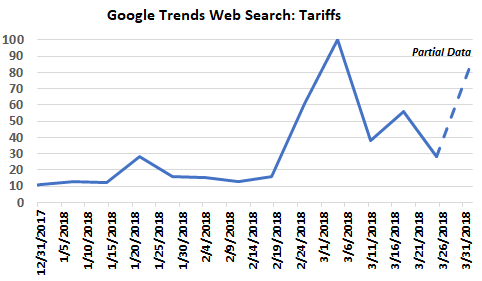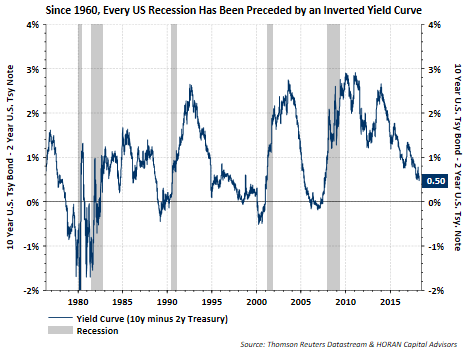Tariffs, Stocks And Recessions
One truism investors know well is the fact the stock market does not perform well in a recession. The recent focus on implementation of tariffs on the U.S.'s largest trading country, China, have some concerned about escalation into an all out trade war and leading to an economic slowdown or recession. Google web search on the term 'Tariffs' has moved higher with the March 1 peak coinciding with the rebound peak for the S&P 500 Index around the same time.


Given strategist and investor concern surrounding the economy, the following charts can provide insight into whether or not the onset of a recession is forth coming.
The shaded areas in the below chart represent recessionary periods in the U.S and the S&P 500 Index (maroon line) clearly takes a turn to the downside during these recession periods. Also, noteworthy on the chart is the continued increase in the year-over-year percentage change in the Leading Economic Indicator, an indication of continued economic strength. More information on the composition of the LEI can be read on The Conference Board's website. In the Conference Board's latest press release, they note:
"The U.S. LEI rose again, despite a sharp downturn in stock markets and weakness in housing construction in February," said Ataman Ozyildirim, Director of Business Cycles and Growth Research at The Conference Board. "The LEI points to robust economic growth throughout 2018. [emphasis added] Its six-month growth rate has not been this high since the first quarter of 2011. While the Federal Reserve is on track to continue raising its benchmark rate for the rest of the year, the recent weakness in residential construction and stock prices – important leading indicators - should be monitored closely."

The Federal Reserve is in the process of normalizing interest rates with 2-3 more rate increases anticipated this year. The Fed Funds rate is now at a level that was reached coming out of the recession that resulted from the bursting of the technology bubble in 2000. Since 1950, every recession has been preceded by a Fed Funds rate rise. The early stages of rate increases tend to not create difficulties for the economy as the Fed simply desires to get short term interest rates to a more normal level. It is later increases, that when pursued, generally are being implemented with the stated intent to slow economic activity and reduce inflationary pressures.

These later increases can result in an inversion of the yield curve, i.e., short term rates higher than long term rates. Every recession since 1960 was preceded by an inverted yield curve, but every inverted yield curve did not signal an impending recession. When the yield curve inverts, there is a 6 to 24 month lag before the onset of a recession. As the below chart shows, although the yield curve has been flattening, a 50 basis point spread remains.

Declining corporate profitability is another factor that may signal an oncoming recession. This profitability decline may be an indication firms are having difficulty passing on price increases to consumers due in part to weakening consumer demand. One area this tends to show up in is unit profitability. The below chart does show this profitability measure was declining from a late 2014 peak. However, unit profitability has turned higher recently, likely due in part to the recent passage of tax reform late last year. Unit profitability now exceeds the level reach prior to the financial crisis.

Rising energy costs can be a precursor to a recession as well. Only one recession in history was not preceded by, or coincident with, an oil price rise. The first chart below shows the YOY change in the PPI for crude petroleum, and like oil, can be a volatile measure. The second chart compares oil inventory to the price of WTI crude oil. WTI has jump higher from a price of below $30 per barrel in early 2016 to above $60 per barrel today. Efficiencies in the energy space have limited the overall rise in the PPI for crude thus limiting the impact of rising oil itself. The rise in per barrel oil prices is certainly worth keeping an eye on though. As the third chart shows, higher oil prices are beginning to be reflected in higher automobile gas prices consumers pay at the pump, having risen from below $2.00 per gallon in 2016 to near $3.00 per gallon today.



This last measure can be an early indicator of building recessionary pressure and it relates to the job market. If the monthly unemployment rate crosses above the 12-month moving average of the same measure, this is a sign businesses are trimming employment. A broad base reduction in employment and the consequent increase in the unemployment rate is generally a sign businesses are seeing weakening demand for their products and services; thus trimming labor costs. Although non-farm payrolls were reported below expectations last Friday, payrolls increased nonetheless and the unemployment rate remains at a low 4.1%.

Much of the recent news flow has centered around tariffs, but maybe other factors are more at play. At the moment, the potential negative influence of rising energy costs on the economy and the Fed's desire to continue to normalize interest rates are two areas we believe justify higher scrutiny. Also, the higher interest rate trend continues to becomes more of an issue due to the need to finance the growing budget deficit in Washington. Working in investors' favor at the moment though is the strength of the corporate sector of the economy. As mentioned earlier, the tax cuts last year are providing a tailwind to business activity and support for a continued acceleration of earnings growth. The noise around tariffs in of themselves may be more noise than a real issue at the moment.
Disclosure: None.



